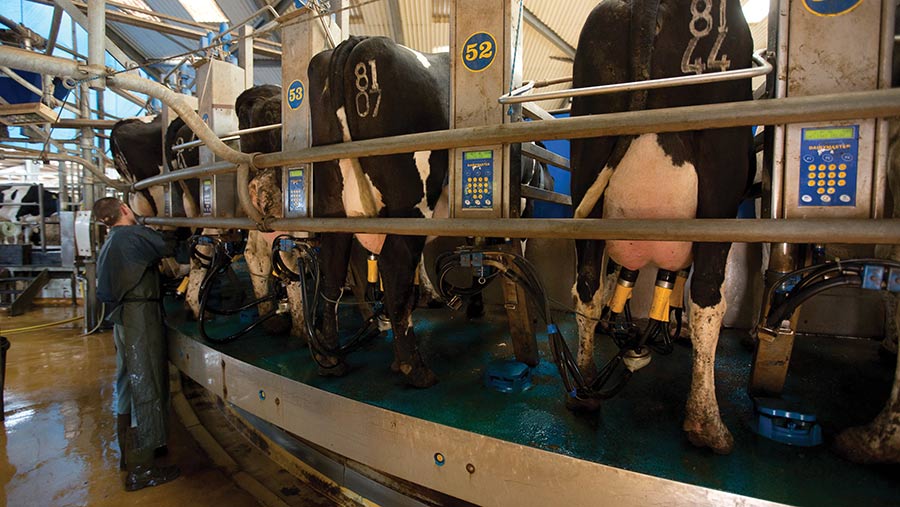6 common farmer milking myths put to the test
 © Tim Scrivener
© Tim Scrivener Having domesticated cows 9,000 years ago, it is tempting to think we know all we need about milking.
The dairy industry has a wealth of experience, with generations of knowledge and expertise for current producers to draw from.
However, some ideas that are accepted as fact may not be as true as we think. Modern milking science can challenge these ideas and explain why we always believed them.
See also: 7 practical ways to get calves through a cold snap
Myth 1: “My cows let their milk down when they hear the milking machine”
We often hear milking teams tell us stimulating milk let-down is not needed, because the cows are already letting their milk down as they arrive in the collecting yard.
Unfortunately, this convenient myth is not true. Cows that are “running their milk” as they walk into the parlour can still have poor milk let-down if they are not stimulated.
This is because the milk that is leaking comes from a different region of the udder to the milk that needs letting down. Milk let-down is a reflex that cannot happen without physical stimulation of the teat.
Verdict: Busted
Myth 2: “Heifers are naturally bad at letting their milk down”
It is true that heifers often have poorer milk let-down than cows. However, managed correctly, heifers can have the same milk let-down success as cows.
For good milk let-down, we need three things: good physical stimulation of the teat, the correct delay between touching the teat and attaching the milking unit, and an absence of stress.
Heifers often require a slightly longer delay between stimulation and milking than cows – without this, milk let-down will suffer. Heifers are also more likely to find milking stressful than cows.
They are not used to the sights, sounds and smells of the milking parlour, so high stress levels disrupt milk let-down. This can be avoided by “parlour training” heifers before they calve.
Stress may also result from an uncomfortable milking. This is common in heifers where the liners are too big for their smaller teats.
A dynamic machine test can often reveal ways of fine-tuning milking to make it a more comfortable experience for heifers.
Verdict: Busted
Myth 3: “Pre-milking teat preparation slows down milking”
Teat preparation obviously requires more effort for the milking team. However, it may not slow down milking as much as people expect.
Although there is a delay in attaching the milking units compared with a routine in which the clusters are immediately attached, the better milk let-down and higher milk flow rates give a shorter ‘unit-on’ time.
This quicker milking usually balances out the time spent on teat preparation. The additional labour may also be balanced out by better udder health.
Investing effort in teat preparation means you should see fewer mastitis cases, reducing the effort spent in managing these cows.
Of course, each herd’s requirements are different, so take advice on the best routine for your situation.
Verdict: Not necessarily true
Myth 4: “Dipping and wiping makes Bactoscan and mastitis worse”
A common response to high levels of environmental mastitis is to use a more thorough pre-milking teat cleaning protocol. However, some teams report this makes their udder health and milk quality worse.
A temporary deterioration in performance may be caused by the wet prep dislodging ingrained dirt from the teats, mobilising previously trapped bacteria.
If poor performance persists, it is usually because the protocol is not being carried out correctly.
The most common problems are not leaving the chemical long enough for successful disinfection, or not wiping the teat dry – especially the tip of the teat. If these details are addressed, wet prep will only ever make performance better.
Verdict: Busted
Myth 5: “Undermilking is a big cause of mastitis”
Incomplete milking can increase the risk of udder infections, but this is not as significant an issue as we have always believed.
A quarter must be severely under-milked to cause mastitis, through mechanisms such as opening of the teat ends caused by pressure from milk accumulation.
The reason this myth has persisted is that during the process of a quarter developing mastitis, it becomes harder to milk out.
We see a quarter that looks undermilked, then a case of mastitis a day later. Actually, it is the mastitis that has led to the under-milking, not the other way around.
Overmilking is a greater risk for infection than undermilking.
Verdict: Busted
Myth 6: “Our rotary parlours milk well with a single operator”
There is a trend for some rotary parlours to be described as “good ‘one-milker’ rotaries”.
Operating a rotary with one person makes it very difficult to achieve an appropriate pre-milking routine for teat hygiene and stimulation.
Maintaining suitable pre-milking protocols with just one milker will eliminate the efficiency gains of the rotary system, reducing the advantages over herringbone parlours.
Automation may allow single-user rotary parlours in the near future, but currently, one-milker rotary operation is not desirable.
Verdict: Busted

